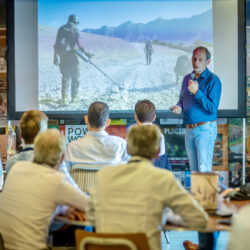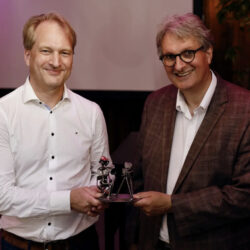Former Commander Mart de Kruif: “Dare to take the right decisions”

The NATO mission in Afghanistan was an enormous logistical operation involving 45,000 soldiers and 12,000 containers. As commander, Lieutenant-General Mart de Kruif realized the importance of a good supply chain firsthand. During the SCM Directors Event of Supply Chain Media, he shared impressive experiences with the top supply chain directors from the Netherlands. “There is only one country in the world that controls the supply chain so well: the United States”.
By Marcel te Lindert
Until 1 November 2008, Mart de Kruif had little experience in logistics. Everything he knew came from theory books. True, early in his career he had been responsible for the logistics of his 140-man unit – he had to ensure sufficient food and fuel and working equipment and vehicles – but he received no logistics training for it. And he was not credited for having any natural talent for logistics. “My first assessment said: he still lacks the primary instincts to create a robust logistics chain,” laughs the army’s former commander.
Logistic hub of Afghanistan
That soon changed when he left for Afghanistan on 1 November 2008 to take over the commandership of the mission in Uruzgan for a year. “I saw there how incredibly important logistics are. And what it means when you fail,” says De Kruif. “We were at Kandahar Airfield next to the busiest runway in the world. Every three minutes an aircraft takes off or lands, 24 hours a day, seven days a week. Around the airport was a camp of 25,000 people who were only concerned with logistics. Kandahar was the logistical hub of Afghanistan.”
The figures are impressive: 7,000 prefab houses were built in one month and two new airports became operational within six months. Crucial goods were transported by air, while less vital goods were escorted from Pakistan by road. “In total, more than 12,000 containers were involved. The loss rate was 1.5 per cent, for example, containers filled with tents or clothing never arrived. They were not crucial but it is annoying when you don’t have them.”
1 kilogram of mail per person
Mart de Kruif commanded 45,000 soldiers. He lists what his team had to deliver per soldier per day: 100 litres of water, 150 litres of fuel, four meals, 5 kilos of spare parts, 2 kilos of ammunition and 1 kilo of mail. “You heard it correctly: 1 kilo of mail per person per day. You don’t want to know what soldiers are sent every day from the Netherlands, as if they are starving. But the biggest risk there is not starvation, but becoming overweight.”
In Afghanistan, De Kruif learned about the supply chain. “There is only one country in the world that can really do it: the United States. If something happens somewhere, there is no discussion about it throughout the entire supply chain. Everyone does what is necessary. It is bizarre what they can achieve. To give an impression of the costs: no less than 16 billion dollars were set aside in the American budget for transportation for a period of six months. The whole operation costs a fortune, but cost was not the most important thing. In an operation like this, effectiveness takes precedence over efficiency.”
The power of diversity
De Kruif’s troops had three tasks in Afghanistan. The first task was to plan the coordination of operations for all 45,000 soldiers. “We were trained for that. We were taught to simultaneously plan at a strategic, tactical and operational level. That is a skill. Secondly, we had to ensure that every wounded soldier could undergo life-saving surgery within an hour. That defined the scope of our operation.”
The third task was to ensure that anyone in ground combat could receive air support within eight minutes. “Why? Because we wanted to avoid civilian deaths. That’s why an extra check was built in to allow the commander to decide whether or not to release a bomb. We had three minutes to make that decision. We took it with a team of six people, two of whom were always women. There I learned the strength of the team and of having diversity.”
Adjusting to a crisis
Not everything went well. Under De Kruif’s leadership, 282 soldiers were killed and 700 were sent home with life changing wounds or amputations. “We released bombs unnecessarily. We hit civilians. What did I learn from that? That you cannot control everything. We tend to want to control everything in every area, but in practice we only control a small part.”
In addition, the ISAF mission in Uruzgan was often surprised by unforeseen events. “What do we do in the Netherlands when we unexpectedly run into a crisis? We panic and roll into the next crisis. My advice: assume that a crisis occurs as standard. How should you then set up your organisation to handle any crisis? If crisis is standard, why not incorporate it into your strategy?”
Dare to take risks
De Kruif mentions three components that determine the success of the armed forces: the physical, conceptual and mental components. According to him, these components also apply to business. “The physical component is the simplest. These are the resources we have at our disposal, such as people, machines and capital. The conceptual component is about the strategy you use. How do you act? Or to speak in football terms: do you play 4-4-2 or 4-3-3?”
With regard to the conceptual component, Mart de Kruif has learned several things, first of all, the importance of standing still now and then. Where are we now? Are we on the right track? “That happens too little, also in business. Another point concerns taking risks. You have to dare to make the right decisions and not be afraid of change. And if you take risks, you also accept that you will make mistakes. Often companies prioritize security above risk, but then where will you be in ten years’ time?”
Mission-type tactics
Explaining the mental component, Mart de Kruif quotes the term ‘mission-type tactics’. During the First World War, more and more decisions were taken centrally, but the Germans realised that this did not work. “They started thinking about it and decided to tell their people what to do and why, but not how. They gave their men the complete freedom to decide for themselves how to achieve their goal. Between the First and Second World Wars, the entire force was trained this way.”
That led to success during May 1940. The Germans did not have more tanks, planes or people, but they did win, “because a German commander could make a decision within two hours, whereas the French and British commanders needed six days. The German decision cycle was so short that they were much faster than any opponent. To apply mission-type tactics successfully you need trust, from top to bottom and from bottom to top,” says De Kruif, who concludes with a final piece of advice. “Think about your people. If you have them on board, you can do anything. You might not always win, but you will win a lot more often.”










